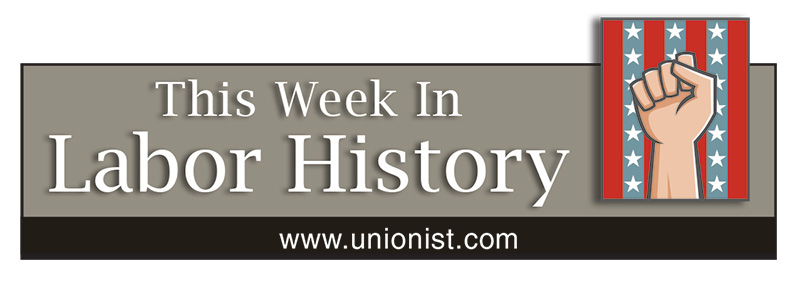This Week in Labor History March 25-31

MARCH 25
1872 – Toronto printers strike for the nine-hour day in what is believed to be Canada’s first major strike.
1894 – First “Poor People’s March” on Washington, in which jobless workers demanded creation of a public works program. Led by populist Jacob Coxey, the 500 to 1,000 unemployed protesters became known as “Coxey’s Army.”
1911 – A total of 146 workers are killed in a fire at New York’s Triangle Shirtwaist Factory, a disaster that would launch a national movement for safer working conditions.
1947 – An explosion at a coal mine in Centralia, Ill., kills 111 miners. Mineworkers President John L. Lewis calls a six-day work stoppage by the nation’s 400,000 soft coal miners to demand safer working conditions.
MARCH 26
1868 – San Francisco brewery workers begin a nine-month strike as local employers follow the union-busting lead of the National Brewer’s Association and fire their unionized workers, replacing them with scabs.
MARCH 27
1904 – Mother Jones is ordered to leave Colorado, where state authorities accuse her of “stirring up” striking coal miners.
2002 – U.S. Supreme Court rules that undocumented workers do not have the same rights as Americans when they are wrongly fired.
MARCH 28
1935 – Members of Gas House Workers’ Union Local 18799 begin what is to become a four-month recognition strike against the Laclede Gas Light Co. in St. Louis. The union later said the strike was the first ever against a public utility in the U.S.
1968 – Martin Luther King, Jr., leads a march of striking sanitation workers, members of AFSCME Local 1733, in Memphis, Tenn. Violence during the march persuades him to return the following week to Memphis, where he was assassinated.
MARCH 29
1852 – Ohio makes it illegal for children under 18 and women to work more than 10 hours a day.
1948 – “Battle of Wall Street,” police charge members of the United Financial Employees’ Union, striking against the New York Stock Exchange and New York Curb Exchange (now known as the American Stock Exchange). Forty-three workers are arrested in what was to be the first and only strike in the history of either exchange.
MARCH 30
1918 – Chicago stockyard workers win eight-hour day.
1930 – At the height of the Great Depression, 35,000 unemployed march in New York’s Union Square. Police beat many demonstrators, injuring 100.
1970 – The federal Coal Mine Health and Safety Act is enacted.
1990 – Harry Bridges, Australian-born dock union leader, dies at age 88. He helped form and lead the Int’l Longshore and Warehouse Union (ILWU) for 40 years.
MARCH 31
1840 – President Martin Van Buren issues a broadly-applicable executive order granting the 10-hour day to all government employees engaged in manual labor.
1883 – Cowboys earning $40 per month begin what is to become an unsuccessful two-and-a-half-month strike for higher wages at five ranches in the Texas Panhandle.
1930 – Construction begins on the three-mile Hawk’s Nest Tunnel through Gauley Mountain, W. Va., as part of a hydroelectric project. A congressional hearing years later was to report that 476 laborers in the mostly Black, migrant workforce of 3,000 were exposed to silica rock dust in the course of their 10-hour-a-day, six-days-a-week shifts and died of silicosis.
1933 – President Franklin D. Roosevelt signs legislation establishing the Civilian Conservation Corps to help alleviate suffering during the Depression. By the time the program ended after the start of World War II, it had provided jobs for more than six million men and boys.
1941 – Wisconsin state troopers fail to get scabs across the picket line to break a 76-day Allis-Chalmers strike in Milwaukee led by UAW Local 248. The plant remained closed until the government negotiated a compromise.
1995 – Federal judge Sonia Sotomayor, later to become a Supreme Court justice, issues an injunction against baseball team owners to end a 232-day work stoppage.
(Compiled by David Prosten, founder Union Communication Services)


Leave a Reply